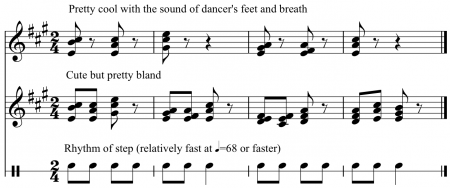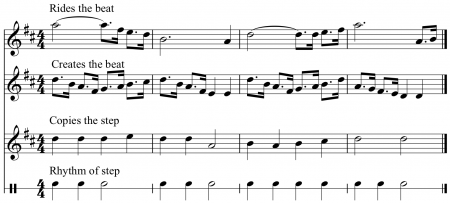
In the last tip, I said that it was a good rule of thumb to divide by half (in your melody line) whatever pulse rate you can detect in a petit allegro jump – if dancers are jumping on quavers, you play semiquavers. Doing this creates a focus on the tempo of the jump by placing aural gridlines over it, so to speak. Now I’m going to contradict that, and say there are times when you’d want to avoid doing that. Sometimes, letting the dancers’ movements divide your beat is better, as Ho Wen Yang, one of my favourite fellow dance pianists pointed out when I published yesterday’s post (his example is shown above).
I learned today’s tip from Christopher Hampson in relation to an exercise in one of his continuous barres that consisted of a long sequence of fast battements jetés. Those classes are wonderful opportunities for trying out ideas because there’s a lot of simple repetition, which means you get the chance to test the principles of accompanying particular movements. When exercises combine movements, or are floridly choreographic, you can’t do this so easily. And as we were working together for several days in succession we could keep refining and talking about the ideas from day to day.
It turns out that doing what I described in yesterday’s tip for an exercise that has a lot of stamina-building repetition is possibly the worst thing you can do, because it does precisely what I said it would do – it draws attention to the pulse of the movement. If you’ve got to do twenty eight battements jetés, you don’t want someone (the music) shouting “17, 18, 19, 20, 21, 22, 23” and so on at you every time you move, emphasising the effort and timing of every single movement. That’s the musical equivalent of paying for your drinks in 1p pieces.

If, on the other hand, the pulse of the music is slower (think Singing in the Rain, let’s say, where you have three ’empty’ beats on the syllable ‘sing-‘) your attention is directed away from the effort, and the many smaller things are chunked into a larger hypermetrical framework. You’ve got 4 pound coins instead of 400 one-pence pieces. Or it’s perhaps similar to the idea that a watched kettle never boils – the more you focus on the passage of time, the slower it seems to pass. For more on that, see Ian Phillips’ article Attention to the passage of time.
If I had to choose between tip 19 and tip 20, which give conflicting advice, I’d usually go for tip 20, because I think the principle of ‘less is more’ is true of ballet accompaniment (see earlier post on making ‘space’ for dancing). But I’d go for 19 if the exercise was not just simple repetition, and the class was for beginners or children, or a complicated exercise where it’s difficult for the dancers to get the rhythm right, and you need to hold the tempo back in odd corners without becoming unrhythmical (which you can do if you’ve got lots of notes to play with). I suspect that it’s got a lot to do with Boltz & Jones’ theory of dynamic attending – the difference between future oriented attending (less notes) and analytic attending (more notes).
Knowing when to do one or the other is part of the skill and judgement that you need as a ballet pianist, and the key is to have both tools ready to deploy instantly so you can switch if one of them isn’t right for the job.

